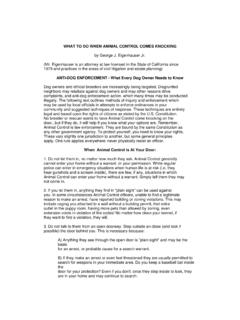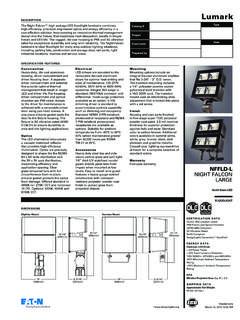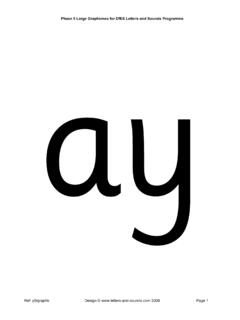Transcription of Optimal feeding of large breed puppies
1 Optimal feeding of large breed puppies Jennifer Larsen DVM, MS Resident, Small Animal Clinical Nutrition Veterinary Medical Teaching Hospital School of Veterinary Medicine, University of California, Davis The feeding of young growing puppies is not as simple as once believed. A number of researchers have been studying the effects of feeding and diet on the growth of puppies , particularly the effects on skeletal development. Although genetics, exercise, trauma, and other aspects of the environment also impact the skeletal development of puppies , the diet is one factor that every owner can control. Several orthopedic diseases of dogs can be precipitated by improper feeding practices during growth. large breeds of dogs are predisposed to these problems because they have the genetic potential for excessively rapid growth. In rapidly growing, large breed puppies , maximal growth, and therefore increased body weight, can cause stress on the immature developing skeleton.
2 large breed dogs have decreased bone density compared to smaller breed dogs at this stage (Dammrich, 1991). Additionally, fast bone growth results in structural defects of bones that are in turn unable to accommodate an increased body weight (Dammrich, 1991). Many nutrients have been studied to determine which components of these diets cause problems. Over 30 years ago a significant amount of data was published that established a connection between improper nutrition and a variety of skeletal abnormalities in Great Danes, including hypertrophic osteodystrophy, osteochondrosis dissecans and 'wobbler' syndrome. The experimental diets varied in protein, energy density, and minerals, and it was unclear which factor or combination thereof contributed to the developmental bone diseases observed in the initial studies (Hedhammar, et. al. 1974). The same group went on to investigate the individual dietary components and demonstrated that dietary protein level had no effect on the development of osteochondrosis (Nap, et.)
3 Al, 1991). For some reason, dietary protein level continues to be incriminated by some owners, breeders, and veterinarians, despite the lack of supportive evidence. In contrast to protein, excessive calories and inappropriate amounts of calcium have both been shown to negatively influence Optimal skeletal development in puppies . While overnutrition in adult dogs leads to obesity and can lead to serious health problems such as cardiorespiratory disease, we recognize other problems in puppies that result from the same practice of overfeeding. It is necessary to feed the puppy enough to allow for controlled growth, but it is equally important to avoid overfeeding. Many people believe that a round puppy is a happy healthy puppy. However, maximal growth is not Optimal growth. Adult size is principally influenced by genetics; however, the time to reach adult size can and should be controlled by proper nutrition.
4 Excess calories can predispose large breed puppies to developmental bone disease, including hypertrophic osteodystrophy (Dammrich, 1991). While any food has the potential to cause problems with skeletal development if overfed or supplemented, maximal growth in puppies is commonly occurs with feeding a highly palatable, high energy density growth diet. These types of diets are often overeaten if fed on a free choice basis, or simply too much is fed on a meal basis. There is currently no perfect formula to guarantee an Optimal rate of growth for an individual puppy. It is especially important to avoid overnutrition during periods of the most rapid growth, which will vary with breed and between individuals. breed and individual differences, environmental factors such as climate, and activity level will all affect the amount of food required. Obviously, palpable body fat is not specific enough to be a guideline for Optimal nutrition.
5 Provide an amount of food that will maintain lean body condition throughout growth. This will allow for a slow growth rate, but won t affect the final adult size. The goal is to keep growing puppies lean at about a body condition score of around 4 on a scale of 1-9 (a score of 1 is emaciated and 9 is grossly obese). You should be able to easily feel the ribs. Study drawings and complete descriptions of the desired body condition. A common body condition scoring system is provided at the following site: One very general suggestion is to provide an amount of food that the puppy can eat in 10 minutes three times a day. Using this as a starting point when the puppy is weaned at seven to nine weeks old, it is recommended to continually assess the puppy s body condition and activity level and adjust the amount of food being offered accordingly. In addition to excessive energy intake, inappropriate amounts of calcium have also been shown to cause developmental bone disease (Hazewinkel, 1989).
6 Many breeders and dog fanciers advocate calcium supplementation for growing pups. Calcium supplements should never be recommended for dogs eating commercially available diets designed for growth. Excess calcium is potentially very detrimental to the development of a healthy skeleton. Unlike adult animals, puppies appear to have inefficient mechanisms for regulating how much dietary calcium they absorb from the food. This can result in absorption and retention of more calcium, especially when the dietary calcium is high (Hazewinkel et. al., 1991, Tryfonidou, 2002). The excessive calcium may result in skeletal malformation (Hazewinkel et. al. 1985). Excess calcium can also cause deficiencies in other nutrients, especially zinc (Wedekind, et. al. 1998). feeding a diet with too little calcium is equally problematic. Many home prepared diets for pets are lacking in calcium.
7 In this case, the skeletal system must provide the calcium for the rest of the body, and brittle, malformed bones are the result. Current recommendations for feeding any healthy dog include choosing a nutritionally complete and balanced dog food that has undergone feeding tests. The guidelines for these tests are established by the Association of American Feed Control Officials (AAFCO). When such a diet is fed, vitamin and mineral supplements are unnecessary and potentially harmful. The common practice of feeding commercially available adult dog foods to puppies can also be detrimental. The broad category of adult canine maintenance foods contains diets with a wide range of nutrient profiles, caloric densities, and mineral contents. Some foods marketed for adult maintenance have passed AAFCO feeding tests for growth, but some have not. Regardless, in some instances, these diets provide more calcium per calorie and/or have more calories per cup than growth diets designed for large breed puppies .
8 A large breed growth diet that has passed AAFCO animal feeding tests should be fed at least until the puppy reaches about 80% of the expected adult weight, and it will not be detrimental to keep a healthy, lean puppy on growth formula until full adult size is achieved. Above all, remember to feed a large breed growth formula in sufficient quantities to maintain a lean body condition, and avoid additional supplements. References Dammrich, K. Relationship between nutrition and bone growth in large and giant dogs. J. Nutr. 1991; 121: 114S-121S. Hazewinkel, , Goedegebuure , Poulos, , Wolvekamp, Influences of chronic calcium excess on the skeletal development of growing Great Danes. J. Am. Anim. Hosp. Assoc. 1985; 21: 377-391. Hazewinkel, Nutrition in relation to skeletal growth deformities. 1989; J. Sm. Anim. Prac. 30: 525-630. Hazewinkel, , van den Brom, , van t Klooster, , Voorhout, G.
9 , van Wees, A. Calcium metabolism in Great Dane dogs fed diets with various calcium and phosphorus levels. J. Nutr. 1991; 121: 99S-106S. Hedhammar, A., Wu. F., Krook, L., Schriver, , De La Hunta, A., Whalen, , Kallfelz, F., Nunez, , Hintz, , Sheffy, , Ryan, Overnutrition and skeletal disease: an experimental study in growing Great Dane dogs. Cornell Veterinary Supplement 1974; 64 (2): 5, 11-160. Lowe J. A., Wiseman J., Cole Zinc source influences zinc retention in hair and hair growth in the dog. J. Nutr. 1994; 124:2575S-2576S. Nap, , Hazewinkel, , Voorhout, G., van den Brom, , Goedegebuure, , van t Klooster, J. Nutr. 1991; 121: 107S-113S. Tryfonidou, , van den Broek, J., van den Brom, , Hazewinkel, Intestinal calcium absorption in growing dogs is influenced by calcium intake and age but not by growth rate. J. Nutr. 2002; 132: 3363-3368.
10 Wedekind, , Lowry, Are organic zinc sources efficacious in puppies ? J. Nutr. 1998; 128: 2593S-2595S.







